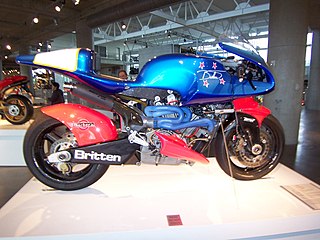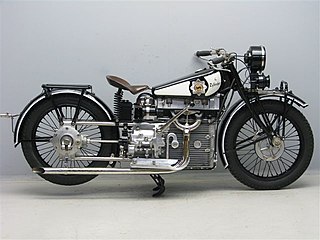
The straight-eight engine or inline-eight engine is an eight-cylinder internal combustion engine with all eight cylinders mounted in a straight line along the crankcase. The type has been produced in side-valve, IOE, overhead-valve, sleeve-valve, and overhead-cam configurations.

A straight-four engine is a four-cylinder piston engine where cylinders are arranged in a line along a common crankshaft.

Georges Louis Frederic Boillot was a French Grand Prix motor racing driver and World War I fighter pilot.

A. J. Stevens & Co. Ltd was a British automobile and motorcycle manufacturer in operation from 1909 to 1931. The company was founded by Joe Stevens in Wolverhampton, England. After the firm was sold, the name continued to be used by Matchless, Associated Motorcycles and Norton-Villiers on four-stroke motorcycles till 1969, and since the name's resale in 1974, on lightweight, two-stroke scramblers and today on small-capacity roadsters and cruisers. The company held 117 motorcycle world records.

Ballot was a French manufacturer, initially of engines, that also made automobiles between 1919 and 1932. Édouard Ballot became well known as a designer of reliable engines. He helped Ettore Bugatti in developing his first engines.

A U engine is a piston engine made up of two separate straight engines placed side-by-side and coupled to a shared output shaft. When viewed from the front, the engine block resembles the letter "U".

An overhead camshaft (OHC) engine is a piston engine where the camshaft is located in the cylinder head above the combustion chamber. This contrasts with earlier overhead valve engines (OHV), where the camshaft is located below the combustion chamber in the engine block.

An overhead valve (OHV) engine is a piston engine whose valves are located in the cylinder head above the combustion chamber. This contrasts with earlier flathead engines, where the valves were located below the combustion chamber in the engine block.

In automotive engineering a multi-valve or multivalve engine is one where each cylinder has more than two valves. A multi-valve engine has better breathing and may be able to operate at higher revolutions per minute (RPM) than a two-valve engine, delivering more power.

A motorcycle engine is an engine that powers a motorcycle. Motorcycle engines are typically two-stroke or four-stroke internal combustion engines, but other engine types, such as Wankels and electric motors, have been used.

The next new Ducati engine to appear after the Ducati Apollo was the 90° V-twin, initial Grand Prix racing versions being 500 cc, and the production bikes were 750 cc. There was also the Ducati 750 Imola Desmo that won at Imola in 1972. These engines had bevel gear shaft drive to the overhead camshaft, and were produced in round, square, and Mille crankcases. In the 1980s these gave way to the belt drive camshaft engines that have continued to this day, in air-cooled and liquid-cooled form. The Mille used a plain bearing crank, like the belt models.

ALFA 40/60 GP or GP was a fully working early racing car prototype made by the company now called Alfa Romeo. Only one example was built in 1914, which was later modified in 1921. This was creation of Giuseppe Merosi and was first Alfa Romeo DOHC engine. It had also four valves per cylinder, 90 degree valve angle and twin spark ignition. Usually Alfa Romeo DOHC engines are thought to be Vittorio Jano's creations but the first one was Merosi's GP car. This kind of engine architecture was very new for the time, originating from 1912/1913 Peugeot designed by Swiss engineer Ernest Henry. The history of this engine architecture is unclear, but other cars with dual overhead camshafts in the were made by Sunbeam, Delage and Humber. This 1914 GP car was intended to take part in French Grand Prix of that year, but for reasons unknown this never happened. In 1921 Giuseppe Campari took part in the Gentlemen G.P. in Brescia with the modified GP car, but was forced to retire due to a leaking radiator.

The 1914 French Grand Prix was a Grand Prix motor race held at Lyon on 4 July 1914. Hailed as one of the greatest races of the twentieth century, it was a contest between the French Peugeots and the German Mercedes. For the first time the Grand Prix was run to an engine limitation – of 4.5L maximum capacity. was won by the Mercedes of Christian Lautenschlager won at an average speed of 105.7 km/h (65.7 mph) after a tense seven-hour contest with the Peugeot of Georges Boillot.

The 1914 Grand Prix season consisted of Grand Prix races across Europe and the United States until abbreviated by the outbreak of World War I.

The Manxman was a motorcycle designed and built by H. J. Hatch and Eric Walker of the Excelsior Motor Company in Tyseley, Birmingham. Although it never won the Isle of Man TT, the Manxman was a very popular and reliable motorcycle which was successful in international racing and the Manx Grand Prix. Production was halted by World War II and did not resume.

The Britten V1000 is a handbuilt race motorcycle designed and built by John Britten and a group of friends in Christchurch, New Zealand during the early 1990s. The bike went on to win the Battle of the Twins in Daytona International Speedway's Daytona Bike Week festivities in the United States and set several world speed records.
Peugeot Motocycles is a French manufacturer of scooters and small motorcycles. The company operates as a subsidiary of Indian manufacturer Mahindra Two Wheelers that owns 100% of Peugeot Motocycles since 2019.

Ernest Henry was a mechanical engineer. He developed auto racing engines, and is especially well known for his work for Peugeot and Ballot, who dominated Grand Prix auto racing from 1912 to 1921. His engine design directly influenced Sunbeam Racing cars as early as 1914; the 1921 Grand Prix Sunbeams owe much to his work with Ballot and the 1922 Grand Prix Sunbeams were designed by him.

Windhoff Motorradenbau GmbH built motorcycles in Berlin, Germany, from 1924-1933. The factory was located at Bülowstrasse 106, Berlin W57, under the direction of factory owner Hans Windhoff. Windhoff initially produced radiators for cars, trucks, and aircraft, setting up a factory with his brother Fritz in Rheine in 1902, then on his own in Berlin from 1907-24. In 1924 he entered the burgeoning German motorcycle market with a water-cooled two-stroke of 125cc. The engine was built under license from a design by Hugo Ruppe, whose ladepumpe design was used most successfully by DKW in their Grand Prix racers. Windhoff had much racing success with these small two-strokes, although an experiment with enlarged two-stroke racers of 493cc and 517cc were less reliable.

Hansen & Schneider were a range of limited production motorcycles produced by the German MV Agusta importers Michael Hansen and engineer Roland Schneider based on the MV Agusta 750 Sport America and the 350 Ipotesi models. The machines were manufactured from 1975 to 1982.


















